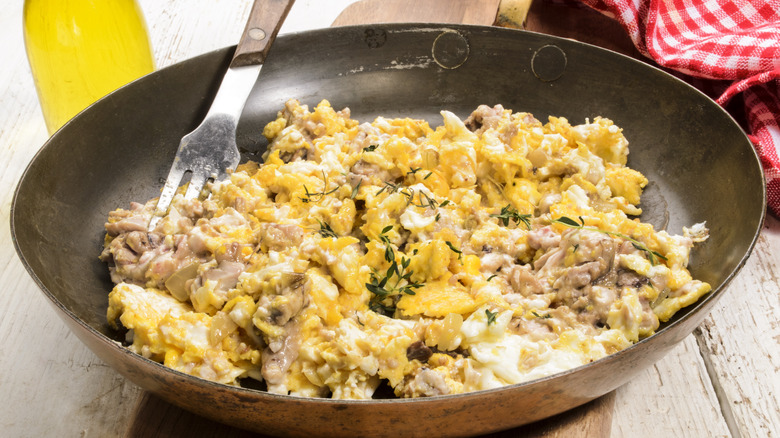Canned Pork Brains And Eggs Used To Be A Southern Staple
Some dishes take the concept of brain food literally. Although you'd have to do a bit of searching and sleuthing to find it these days, canned pork brains — fresh pork brains too — and eggs used to be the breakfast of champions in the South. The meal took the concept of not letting any part of the animal go to waste to heart. Pork brains used to be a staple for many families in the South, and it became so popular for a time that several manufacturers sold cans of pork brains on store shelves. You can still find cans of pork brains today, though it's fallen out of favor.
Traditionally, the meal was served with a heaping of eggs, forming a scramble of sorts. Home cooks would fry up pork brains in a skillet, mixed with seasonings. Typically, the meal would be served with biscuits as a breakfast sandwich. The texture of pork brains is similar to tofu, described as soft and fatty. Fans of the dish prefer fresh pork brains for quality sake but would settle for canned pork brains in a pinch.
For those who've tried canned pork brains for the first time, it can be a bit overwhelming. Bill Walker, chef at the Kennison, told the Chicago Reader that canned pork brains were similar to cat food. He said, "The smell is more off-putting than the taste. The texture's really strange. They just disintegrate in your mouth — not in a good way."
The origins of canned pork brains and eggs
The South by no means has a monopoly on eating pork brains. Humanity has consumed brains since the early days of mankind with Roman cookbooks detailing how to make brain-stuffed sausages. In China, cooks will add pig brains as an ingredient to hot pot dishes — the ingredient favored for its ability to absorb the soup's broth. In the Midwest, fried beef brain sandwiches were a delicacy throughout the 20th Century.
The Southern staple of pork brains and eggs likely arose among farmers looking to use every part of their livestock of pigs. While other parts of the pig such as sausages and hams would keep for longer, it wasn't possible to preserve the hog's organs. As such, families would serve the brains of the pig with eggs during the morning after the slaughter as a way to quickly consume the meat.
As for canned pork brains, it's likely that World War II played a role in their popularity. During WWII, the country faced a meat shortage. As such, Americans back home were encouraged to eat less desirable parts of the animal such as the brain. Companies began to can and offer pig brains on the store shelves. For a time, it wasn't uncommon to find canned pork brains on the shelves of your local grocery store in the South. However, the breakfast staple has mostly gone away.
The decline of canned pork brains
It appears that the decline of canned pork brains and really pork brains, in general, is a generational one in the South. While there's an older generation of Southerners who swear by the meal as a tradition, the younger generations have mostly ignored the breakfast dish as a staple of the past. Vivian Howard, a chef at Chef and Farmer in North Carolina, told Garden and Gun, "When I talk with people about brains and eggs, it's always older people, and they talk about it like it's a cheeseburger, like I should know about it."
So why have pork brains fallen out of favor? It's possible that their cholesterol levels may have played a role. For instance, a can of Rose Brand Pork Brains contains cholesterol that's 1060% of the daily recommended amount. The canned brains also have a high level of sodium as well. Speaking of Rose Brand Pork Brains, they are the last manufacturer of canned pork brains. Previously, Armour and Kelly's both sold canned pork brains. However, both manufacturers have discontinued the product over the years.
It's possible that public awareness around Creutzfeldt-Jakob disease or Mad Cow disease may have had a trickle-down effect as well. The disease did all but kill the popularity of fried beef brain sandwiches in the Midwest, after all. While pigs can't contract the disease, the public conversation around brains as food has shifted. With meat more readily available, pork brains have become a more niche delicacy reserved for the daring.


